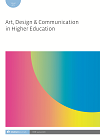
Full text loading...

This article presents a reflection on a common strategy for the education of designers – the studio – in relation to the dynamic evolution of design practice. This reflection is based on ethnographic observations of service designers as they engaged with clients from the public policy sector. These observations provoked a critical questioning of the way that design education is realized through the simulation of practice in studio settings and the ability to respond to the dynamic evolution of designers’ practice when faced with novel challenges. The article concludes with a suggestion for moving from an understanding of studio pedagogy as a predominantly spatial setting towards that of the studio as an open organizational form that might be capable of more appropriately integrating the socially distributed and boundary-crossing character of modern design practice.

Article metrics loading...

Full text loading...
References


Data & Media loading...

Publication Date:
https://doi.org/10.1386/adch_00063_1 Published content will be available immediately after check-out or when it is released in case of a pre-order. Please make sure to be logged in to see all available purchase options.